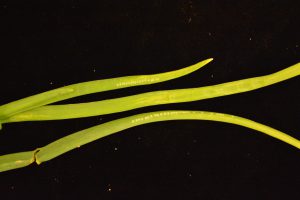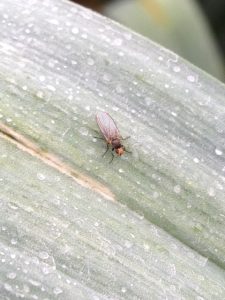The first Allium leafminer (ALM) oviposition scars were reported in Cape May this past weekend (38.9588N, 74.9082W), suggesting that adults are active in the southern part of the state. ALM are active around 250 GDDs. If you want to know how many GDDs have accumulated in your area, the NEWA website https://newa.cornell.edu/ has a helpful GDD calculator. From the NEWA home screen, select the nearest weather station from the drop-down menu at the center of the page. Next, scroll down to “Weather Tools” on the right side of the page and select “DD Calculator.” Select your start date (1/01/25) and end date, as well as Degree Day Type (39 F) from the menu at the left of the page. The site will automatically generate the accumulated GDD base 39 F to the last day of your requested sample, and then offer a forecast of accumulated GDD for the next week.
ALM can cause injury to chives, scallions, garlic, onions and leeks, but leeks and scallions seem to be the most effected. Look for neat rows of white spots descending from the upper tips of allium leaves (see photo below). Initial injury often occurs on the tallest leaves. Adults may be seen in warmer conditions at the tips of the leaves- look for small flies with grey-black bodies and yellow heads (see photo below).
If you are concerned about crop injury due to Allium leafminer, you may want to prepare for control efforts. Floating row covers, kept on until the first flight ends (around the end of May) can restrict ALM’s access to vulnerable plants. Adults can be targeted through insecticide sprays. Appropriate materials that are labeled for ALM control include spinosyns (Radiant, Entrust (OMRI approved)), pyrethroids (Mustang Maxx, Warrior), neonicotinoids (Scorpion, Venom), and the insect growth regulator Trigard. The first application should be applied 2- 3 weeks after initial detection of ALM flies (if you see oviposition scars or the fly itself) and subsequent sprays should be completed in 1–2-week intervals. Two or three sprays should provide adequate control.

Notice the white oviposition scars and an adult female ALM. Photo: Brian A. Nault, Cornell AgriTech.
If you have any questions/concerns, feel free to reach out to me at amanda.quadrel@rutgers.edu or 732-742-8441.


